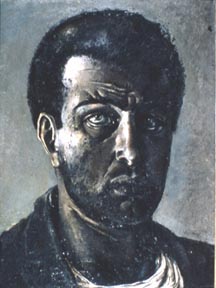
Howard Warshaw
American , 1920-1977
Self-Portrait as a Young Man, 1945
oil on canvas
SBMA, Anonymous gift in memory of Henry Seldis
1978.8
RESEARCH PAPER
The life of Howard Warshaw
Howard Warshaw was considered one of the leading Los Angeles Modernists. According to his good friend and collegue Joseph Mangon, Warshaw believed that art was an on going continuum going back to the cave paintings and advancing up to the present. Art never improved but was always changing; the present always dependent on the past and always altaring our view of it. He further believed that art should be expressed indirectly through expression and use of the medium, by way of emotion.
Howard Warshaw was born in New York on August 14, 1920. He was a cartoonist for his high school newspaper. He trained with Homer Boss and Robert Trafton, who gave him inspiration in what he called, the "the history of graphic ideas", at the Art Students League. He also underwent courses at the Pratt Art Institute.
He tried to enlist in the Army, during World War II, but was disqualified due to a bad knee. He moved to Los Angeles with his parents and was hired as an animator at the Walt Disney Studios. He painted in his spare time and was given the opportunity to show his work at the James Vigeveno Gallery. The actor-collector Vincent Price discovered his work and bought several of his works. Inspired by Price's investment, Warshaw moves to New York to paint full-time. An art dealer, Julien Levy was very much impressed by his work, and gave him a show in 1946 and 1948.
Warshaw returned to Los Angeles, this time working as an animator for Warner Brothers drawing Bug Bunny cartoons. He encountered Vincent Price again and was invited to live and work at the actor's Benedict Canyon Estate. Price gave Warshaw a solo show at his gallery called The Little Gallery in Beverly Hills, which he ran with fellow actor George Macready. During his opening, Warshaw met many celebrities - John Barrymore, William Brice, Igor Stravinsky, and Eugene Bergman, to name a few.
Warshaw depicted quite vividly the post war depression and was honored with many awards. Example, he won two first prizes at the Los Angeles County Museum of Art at their California Centennials Exhibition. These honors gave him national recognition in magazines such as Time and Life Magazine in 1950.
He begun a series of works where he depicted car accidents, blurred traffic signals, and striped curbs, which may have been influenced by his experience with film animation. He further utilized the "graphic ideas" into-his work.
During the 1950's, Warshaw executed mural work at places such as the Wyle Laboratories in El Segundo, California and at the University of California campuses at Santa Barbara, San Diego, Los.Angeles, and Riverside.
Warshaw began teaching at the University of California, Santa Barbara in 1956. He was promoted to the rank of associate professor in 1963 and professor in 1967. He was then in charge of the graduate program in 1965.
Howard Warshaw was inflicted with cancer, succumbing in August 1977. He is remembered by his humor, wit, and as one of the leading advocates of the Los Angeles modernists.
Information transcribed from Docent file.
Prepared for SBMA website 2008, LG.
